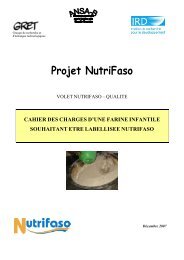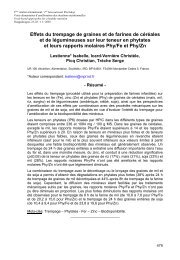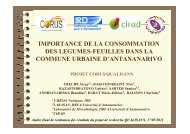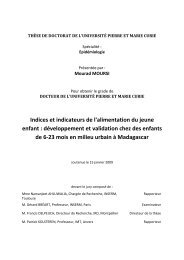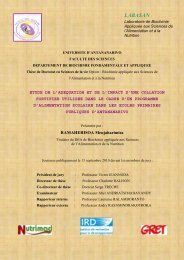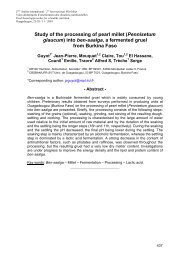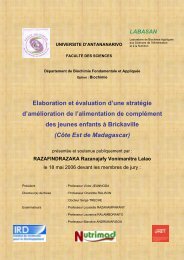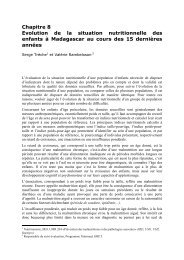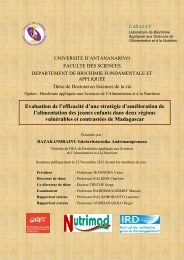THESE UNIQUE El Hassane Kéhien-Piho TOU - Nutridev
THESE UNIQUE El Hassane Kéhien-Piho TOU - Nutridev
THESE UNIQUE El Hassane Kéhien-Piho TOU - Nutridev
You also want an ePaper? Increase the reach of your titles
YUMPU automatically turns print PDFs into web optimized ePapers that Google loves.
Food processing at household and community level<br />
- Abstract -<br />
Attempt of modification of traditional processing of pearl millet<br />
into fermented gruel ben-saalga, to improve its energy density<br />
The fermented millet gruels, ben-saalga, produced and commercialized in<br />
Ouagadougou, are widely accepted and consumed by the population, particularly by<br />
the young children. However, these gruels, as most of traditional gruels in Africa, have<br />
a low energy density (ED) (on average, 30 kcal/100g of gruel). The processing of pearl<br />
millet into ben-saalga comprises the following successive main steps: soaking the<br />
grains (first fermentation), grinding and filtration of humid flour, decanting (second<br />
fermentation) and cooking. This study aimed to improve the ED of ben-saalga by<br />
modifying this traditional processing in introducing intermediary steps of precooking<br />
and/or barley malt incorporation.<br />
The modifications (precooking and barley malt incorporation) were chosen because of<br />
their potentiality to partially hydrolyse starch, thus allowing the preparation of high ED<br />
gruels. The modifications tested were (i) adding a precooking of 10 min after filtration<br />
stage to gelatinize the starch in order to enable the amylase attack and/or (ii)<br />
incorporate the barley malt (amylase source) at the beginning of decantation step at<br />
the rate of 1% of dry matter of the humid flour. The consistency of gruels prepared<br />
following the different processes was measured with a Bostwick consistometer in<br />
mm/30s at 45°C. During the decantation, the kinetics of acidification of the dough were<br />
registered with a pH-meter (WTW 340i).<br />
The process combining both steps of precooking and barley malt incorporation<br />
allowed the preparation of high ED gruels (152 kcal/100g of gruel) having an<br />
appropriate consistency (Bostwick flow distance of 120mm/30s). On the other hand,<br />
each of these steps, tested individually, gave low ED gruels (24 and 30 kcal/100g of<br />
gruel, respectively) for the same Bostwick flow distance value, similar to the one of the<br />
traditional gruel. Barley malt incorporation did not modify the kinetics of acidification of<br />
the dough during decantation. However, the introduction of a precooking step induced<br />
a modification of the kinetics of acidification due to the destruction of the natural<br />
microflora and characterized by an important extension (up to 8 hours) of latency<br />
period. During this long latency period, the dough could undergo biochemical and<br />
bacteriological damages<br />
The process combining both steps of modification proved highly efficient to increase<br />
the ED of gruels (on average, 440% more than the one of traditional gruel) and<br />
considerably delay the start of the fermentation. This disadvantage could be discarded<br />
through dough inoculation by the back-slopping technique.<br />
Key words: Complementary food – Pearl millet fermented gruel – Energy density –<br />
Barley malt.<br />
_________________________<br />
518



